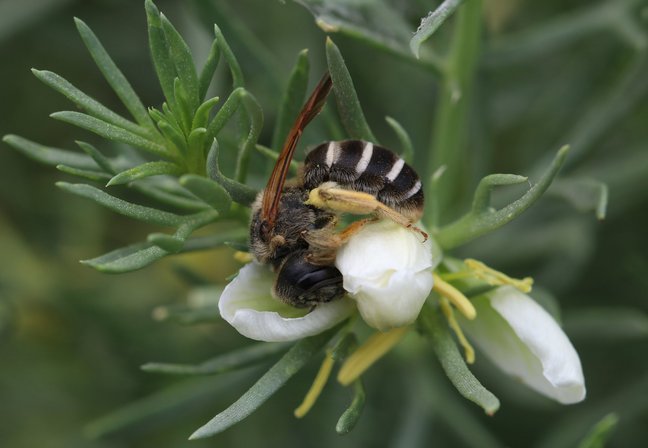Stuttgart, 12.09.2023. In the wake of the climate crisis and the decline in insect populations, countless studies on bees have made headlines in recent years. Among them are many calls for protective measures to stem or halt the decline of bees and other pollinators. Almost all of these studies were conducted in Western countries and are not representative of the rest of the world. To call for increased efforts to protect bees in Asia, 74 scientists* from over 13 countries, led by Dr. Michael Orr of the State Museum of Natural History Museum Stuttgart, Germany, have now come together to create a roadmap for the future of bee research in Asia. The team has published this plan in the journal Biological Conservation.
Important ecosystem services for biodiversity conservation in Asia
Conservation in Asia is critical because more than half of the world's population lives in the region and food security remains a major challenge. This means that we have little time left to protect important ecosystems and conserve habitats, the species that live in them, and the services they provide. In this regard, native bees play a key role for Asia, both ecologically and economically. Understanding how to manage and conserve bee diversity is therefore critical for sustainable development in the region.
Detailed knowledge of distribution and ecology needed
Bees are among the world's most important and well-known pollinators in the animal kingdom. They are indispensable for the species conservation of many plants as well as for agriculture. Especially in many densely populated regions of Asia, pollinating insects play a crucial role. Of the approximately 20,000 wild bee species described worldwide, about 15 % live in the Asian region. However, these have hardly been studied so far. "The biggest obstacle is the lack of knowledge about where and how species live, as well as the lack of expertise to accurately identify species. Together, these problems affect virtually all downstream research," said Dr. Michael Orr.
Expanding fundamental knowledge in the field, collaborations, public outreach
The authors strongly recommend that more resources be invested in building basic knowledge about bee biodiversity in Asia.
Alongside and building on these efforts, ecological studies need to be conducted at the national and regional levels to better understand how best to sustain pollinator communities and the ecosystem services they provide.
"Transborder partnerships must be the focus of future efforts. Given the complex political dynamics in the region, science and research can help bridge some of these divides, but more open sharing of samples and data is key," said Dr. Michael Orr.
To reach their maximum potential, conservation efforts must also be multidisciplinary, the authors said. They must link disciplines and methodologies, as well as government, NGO and research personnel, to better translate research into practical applications and effective conservation management for bees throughout Asia. Researchers also feel it is particularly important to use high-profile activities to solicit more political and societal support.
Particular attention needs to be paid in bee conservation in Asia to species that are protected, such as the world's largest bee, the Indonesian Megachile pluto, which is often sold online for exorbitant sums to Western buyers despite being classified as "endangered" by the IUCN.
For the editors
Original publication:
Warrit, N., et al. 2023. opportunities and challenges in Asian bee research and conservation. Biological Conservation, 110173.
DOI: 10.1016/j.biocon.2023.110173
Publication date: 08/07/2023.
State Museum of Natural History Stuttgart:
The State Museum of Natural History Stuttgart is a future-oriented research and communication institute. Its research collections, the archives of diversity, contain over 12 million objects. The museum researches the evolution of life and analyzes the biodiversity of different ecosystems and communicates research findings to the general public.
www.naturkundemuseum-bw.de
Contact:
Dr. Michael C. Orr
State Museum of Natural History Stuttgart, Germany
Phone +49/(0)711/89 36/237
E-mail: michael.orr(at)smns-bw.de
Dr. Michael Orr is available for further information and interviews.
Press contact:
Meike Rech
State Museum of Natural History Stuttgart, Germany
Phone +49/(0)711/8936/107
E-mail: meike.rech(at)smns-bw.de
Image material:
Image 1: Image1_Ceratina_sp__Michael_Orr
Description: Unlike most bees that nest in the ground, these Ceratina bees nest in twigs that hollow out. Photographed in Xishuangbanna.
Copyright notice: Michael Orr
Image 2: Image2_Halictus_sp__Qingsong_Zhou
Description: This Halictus bee is one of the 15% of bee species that are social. This means that they live together in cooperative groups, much like the more familiar honeybees. Photographed in Beijing.
Copyright notice: Qingsong Zhou
Image 3: Image3_Nomada_sp__Qingsong_Zhou
Description: Bees come in all shapes and sizes, but the parasitic bees of the genus Nomada are unusual because of their wasp-like appearance. Photographed in Beijing.
Copyright notice: Qingsong Zhou
Image 4: Image4_Thyreus_sp__Michael_Orr
Description: This bright blue Thyreus bee from West Papua is a parasitic bee, meaning it invades and takes over the nests of other bee species to care for its offspring. Recorded in Cenderawasih.
Copyright notice: Michael Orr
Please note that use of the photographic material is only permitted with copyright notice. Thank you very much.
